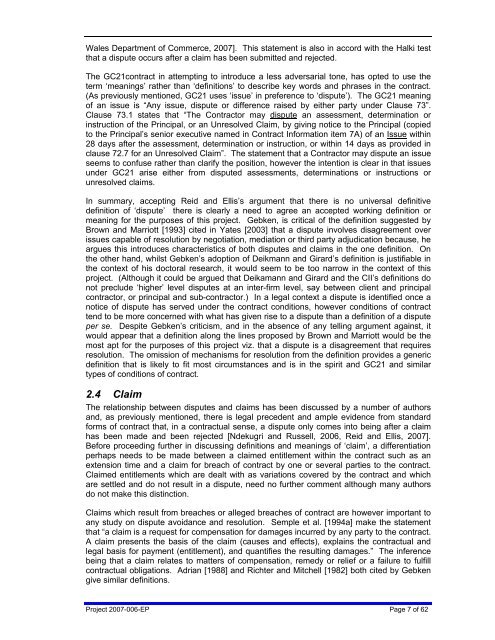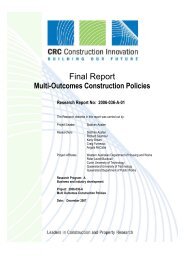Dispute Avoidance and Resolution (literature review) - Construction ...
Dispute Avoidance and Resolution (literature review) - Construction ...
Dispute Avoidance and Resolution (literature review) - Construction ...
Create successful ePaper yourself
Turn your PDF publications into a flip-book with our unique Google optimized e-Paper software.
Wales Department of Commerce, 2007]. This statement is also in accord with the Halki testthat a dispute occurs after a claim has been submitted <strong>and</strong> rejected.The GC21contract in attempting to introduce a less adversarial tone, has opted to use theterm ‘meanings’ rather than ‘definitions’ to describe key words <strong>and</strong> phrases in the contract.(As previously mentioned, GC21 uses ‘issue’ in preference to ‘dispute’). The GC21 meaningof an issue is “Any issue, dispute or difference raised by either party under Clause 73”.Clause 73.1 states that “The Contractor may dispute an assessment, determination orinstruction of the Principal, or an Unresolved Claim, by giving notice to the Principal (copiedto the Principal’s senior executive named in Contract Information item 7A) of an Issue within28 days after the assessment, determination or instruction, or within 14 days as provided inclause 72.7 for an Unresolved Claim”. The statement that a Contractor may dispute an issueseems to confuse rather than clarify the position, however the intention is clear in that issuesunder GC21 arise either from disputed assessments, determinations or instructions orunresolved claims.In summary, accepting Reid <strong>and</strong> Ellis’s argument that there is no universal definitivedefinition of ‘dispute’ there is clearly a need to agree an accepted working definition ormeaning for the purposes of this project. Gebken, is critical of the definition suggested byBrown <strong>and</strong> Marriott [1993] cited in Yates [2003] that a dispute involves disagreement overissues capable of resolution by negotiation, mediation or third party adjudication because, heargues this introduces characteristics of both disputes <strong>and</strong> claims in the one definition. Onthe other h<strong>and</strong>, whilst Gebken’s adoption of Deikmann <strong>and</strong> Girard’s definition is justifiable inthe context of his doctoral research, it would seem to be too narrow in the context of thisproject. (Although it could be argued that Deikamann <strong>and</strong> Girard <strong>and</strong> the CII’s definitions donot preclude ‘higher’ level disputes at an inter-firm level, say between client <strong>and</strong> principalcontractor, or principal <strong>and</strong> sub-contractor.) In a legal context a dispute is identified once anotice of dispute has served under the contract conditions, however conditions of contracttend to be more concerned with what has given rise to a dispute than a definition of a disputeper se. Despite Gebken’s criticism, <strong>and</strong> in the absence of any telling argument against, itwould appear that a definition along the lines proposed by Brown <strong>and</strong> Marriott would be themost apt for the purposes of this project viz. that a dispute is a disagreement that requiresresolution. The omission of mechanisms for resolution from the definition provides a genericdefinition that is likely to fit most circumstances <strong>and</strong> is in the spirit <strong>and</strong> GC21 <strong>and</strong> similartypes of conditions of contract.2.4 ClaimThe relationship between disputes <strong>and</strong> claims has been discussed by a number of authors<strong>and</strong>, as previously mentioned, there is legal precedent <strong>and</strong> ample evidence from st<strong>and</strong>ardforms of contract that, in a contractual sense, a dispute only comes into being after a claimhas been made <strong>and</strong> been rejected [Ndekugri <strong>and</strong> Russell, 2006, Reid <strong>and</strong> Ellis, 2007].Before proceeding further in discussing definitions <strong>and</strong> meanings of ‘claim’, a differentiationperhaps needs to be made between a claimed entitlement within the contract such as anextension time <strong>and</strong> a claim for breach of contract by one or several parties to the contract.Claimed entitlements which are dealt with as variations covered by the contract <strong>and</strong> whichare settled <strong>and</strong> do not result in a dispute, need no further comment although many authorsdo not make this distinction.Claims which result from breaches or alleged breaches of contract are however important toany study on dispute avoidance <strong>and</strong> resolution. Semple et al. [1994a] make the statementthat “a claim is a request for compensation for damages incurred by any party to the contract.A claim presents the basis of the claim (causes <strong>and</strong> effects), explains the contractual <strong>and</strong>legal basis for payment (entitlement), <strong>and</strong> quantifies the resulting damages.” The inferencebeing that a claim relates to matters of compensation, remedy or relief or a failure to fulfillcontractual obligations. Adrian [1988] <strong>and</strong> Richter <strong>and</strong> Mitchell [1982] both cited by Gebkengive similar definitions.Project 2007-006-EP Page 7 of 62
















